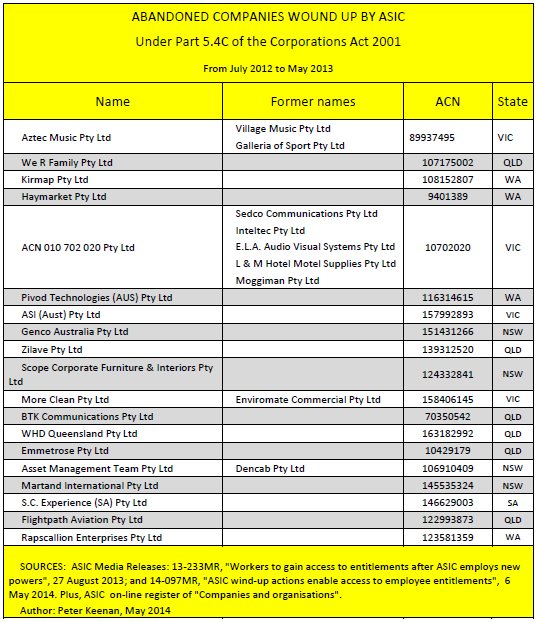Australia’s corporate regulator, the Australian Securities and Investments Commission, estimates that 10 per cent of its 362 statutory forms could be removed, consolidated or streamlined in the name of reducing “red tape”.
This is revealed in Report 391 – ASIC’S deregulatory initiatives, published on 7 May 2014.
Removal
Those forms identified for possible removal include ones which ASIC says are “not required or used regularly by ASIC or the public”. ASIC says that:
A number of the forms identified for removal are currently required to be provided to ASIC under the law, but provide information that might not be necessary for ASIC to hold. Subject to stakeholder comments, we may suggest that these forms be removed through legislative amendment.
Other forms are marked for removal on the basis that:
- the “information is available from the company”;
- they are “obsolete“; and
- they are “Administrative only”.
Forms that may no longer be required in corporate insolvency administration
Below I’ve listed the insolvency forms identified by ASIC for removal because the “information is not used by ASIC” *. (Per Table 1 of Appendix 1 of Report 391.)
- Form 540 – Statement in writing of posting of notices of appointment to settle list of contributories – Reg. 5.6.59(2)
- Form 545 – Statement in writing of giving notice to persons placed on the list of contributories – Reg.5.6.62(5)
- Form 555 – Notice of controller extending time to submit report as to affairs – S.429(4)
- Form 558 – Court order extending time to provide report as to affairs – S.429(5)
- Form 562 – Notice of liquidator extending time to submit report as to affairs – S.475(7)(b)
- Form 911 – Verification or certification of a document – Reg. 1.0.16
* NOTE: The phrase “Information not used by ASIC” used in the Appendix appears to be an abbreviation of the phrase “information not required or used regularly by ASIC or the public”.
Forms that, if removed, could impair corporate insolvency administration
ASIC has marked other forms for possible removal because “the information is available from the company“. But liquidators of small companies – especially “phoenix” companies – frequently find it difficult or impossible to obtain information from the company. So removal of the following forms (or, more precisely, the requirement to lodge them with ASIC) may impair the efficient investigation of insolvent companies:
- Form 909 – Notification of office at which registers are kept – Sections 100(1)(d), 172, 271, 1302(4) and 601CZC
- Form 991 – Notification of location of books on computer – Sections 1301 and 1301(4) – inspection of books
- Form 992 – Notification of change of location of books kept on computer – Sections 1301 and 1301(4) – inspection of books
- Form 313 – Notification of address in Australia of information relating to financial records kept outside Australia – Section 289(2) – place where records are kept outside the jurisdiction. (See next heading.)
Cloud computing
In recent years the uptake of cloud computing services by Australian businesses has increased dramatically. One common characteristics of cloud computing is that business books and records are held outside the Australian jurisdiction. Under section 289 of the Corporations Act 2001 “if financial records about particular matters are kept outside the (Australian) jurisdiction, sufficient written information about those matters must be kept in this jurisdiction to enable true and fair financial statements to be prepared (and) the company must give ASIC written notice in the prescribed form of the place where the information is kept”.
The proposed removal of Form 313 shows that this requirement is to be abolished.
Simplification and consolidation
Two form used in corporate insolvency administration are marked for simplification:
- Form 529 Notice of meeting: Creditors to consider voluntary winding up
Form 905A Notification of ceasing to act as or change of details of a liquidator.
Ideas and Comments

ASIC is seeking ideas and/or comments to be submitted to it by 18 June 2014. These are to be sent to:
Ashly Hope, Strategic Policy Advisor
Australian Securities and Investments Commission
GPO Box 9827 Melbourne VIC 3001
Email: deregulation@asic.gov.au
Sources and links:
ASIC Media Report 14-099MR “ASIC reports on red tape reduction and invites feedback”, 7 May 2014
Report 391 ASIC’s deregulatory initiatives published 7 May 2014. ASIC says: “This report provides an overview of ASIC’s commitment to reduce compliance costs for our regulated population, including ongoing work and new initiatives. It should be read by all businesses and individuals who are required to comply with laws and regulations administered by ASIC and those who have an interest in engaging with ASIC on our approach to deregulation.”


